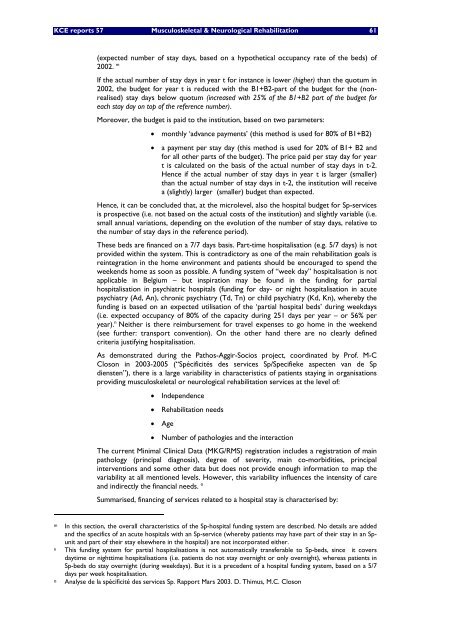The report is available in English with a French summary - KCE
The report is available in English with a French summary - KCE
The report is available in English with a French summary - KCE
Create successful ePaper yourself
Turn your PDF publications into a flip-book with our unique Google optimized e-Paper software.
<strong>KCE</strong> <strong>report</strong>s 57 Musculoskeletal & Neurological Rehabilitation 61<br />
(expected number of stay days, based on a hypothetical occupancy rate of the beds) of<br />
2002. m<br />
If the actual number of stay days <strong>in</strong> year t for <strong>in</strong>stance <strong>is</strong> lower (higher) than the quotum <strong>in</strong><br />
2002, the budget for year t <strong>is</strong> reduced <strong>with</strong> the B1+B2-part of the budget for the (nonreal<strong>is</strong>ed)<br />
stay days below quotum (<strong>in</strong>creased <strong>with</strong> 25% of the B1+B2 part of the budget for<br />
each stay day on top of the reference number).<br />
Moreover, the budget <strong>is</strong> paid to the <strong>in</strong>stitution, based on two parameters:<br />
• monthly ‘advance payments’ (th<strong>is</strong> method <strong>is</strong> used for 80% of B1+B2)<br />
• a payment per stay day (th<strong>is</strong> method <strong>is</strong> used for 20% of B1+ B2 and<br />
for all other parts of the budget). <strong>The</strong> price paid per stay day for year<br />
t <strong>is</strong> calculated on the bas<strong>is</strong> of the actual number of stay days <strong>in</strong> t-2.<br />
Hence if the actual number of stay days <strong>in</strong> year t <strong>is</strong> larger (smaller)<br />
than the actual number of stay days <strong>in</strong> t-2, the <strong>in</strong>stitution will receive<br />
a (slightly) larger (smaller) budget than expected.<br />
Hence, it can be concluded that, at the microlevel, also the hospital budget for Sp-services<br />
<strong>is</strong> prospective (i.e. not based on the actual costs of the <strong>in</strong>stitution) and slightly variable (i.e.<br />
small annual variations, depend<strong>in</strong>g on the evolution of the number of stay days, relative to<br />
the number of stay days <strong>in</strong> the reference period).<br />
<strong>The</strong>se beds are f<strong>in</strong>anced on a 7/7 days bas<strong>is</strong>. Part-time hospital<strong>is</strong>ation (e.g. 5/7 days) <strong>is</strong> not<br />
provided <strong>with</strong><strong>in</strong> the system. Th<strong>is</strong> <strong>is</strong> contradictory as one of the ma<strong>in</strong> rehabilitation goals <strong>is</strong><br />
re<strong>in</strong>tegration <strong>in</strong> the home environment and patients should be encouraged to spend the<br />
weekends home as soon as possible. A fund<strong>in</strong>g system of “week day” hospital<strong>is</strong>ation <strong>is</strong> not<br />
applicable <strong>in</strong> Belgium – but <strong>in</strong>spiration may be found <strong>in</strong> the fund<strong>in</strong>g for partial<br />
hospital<strong>is</strong>ation <strong>in</strong> psychiatric hospitals (fund<strong>in</strong>g for day- or night hospital<strong>is</strong>ation <strong>in</strong> acute<br />
psychiatry (Ad, An), chronic psychiatry (Td, Tn) or child psychiatry (Kd, Kn), whereby the<br />
fund<strong>in</strong>g <strong>is</strong> based on an expected util<strong>is</strong>ation of the ‘partial hospital beds’ dur<strong>in</strong>g weekdays<br />
(i.e. expected occupancy of 80% of the capacity dur<strong>in</strong>g 251 days per year – or 56% per<br />
year). n Neither <strong>is</strong> there reimbursement for travel expenses to go home <strong>in</strong> the weekend<br />
(see further: transport convention). On the other hand there are no clearly def<strong>in</strong>ed<br />
criteria justify<strong>in</strong>g hospital<strong>is</strong>ation.<br />
As demonstrated dur<strong>in</strong>g the Pathos-Aggir-Socios project, coord<strong>in</strong>ated by Prof. M-C<br />
Closon <strong>in</strong> 2003-2005 (“Spécificités des services Sp/Specifieke aspecten van de Sp<br />
diensten”), there <strong>is</strong> a large variability <strong>in</strong> character<strong>is</strong>tics of patients stay<strong>in</strong>g <strong>in</strong> organ<strong>is</strong>ations<br />
provid<strong>in</strong>g musculoskeletal or neurological rehabilitation services at the level of:<br />
• Independence<br />
• Rehabilitation needs<br />
• Age<br />
• Number of pathologies and the <strong>in</strong>teraction<br />
<strong>The</strong> current M<strong>in</strong>imal Cl<strong>in</strong>ical Data (MKG/RMS) reg<strong>is</strong>tration <strong>in</strong>cludes a reg<strong>is</strong>tration of ma<strong>in</strong><br />
pathology (pr<strong>in</strong>cipal diagnos<strong>is</strong>), degree of severity, ma<strong>in</strong> co-morbidities, pr<strong>in</strong>cipal<br />
<strong>in</strong>terventions and some other data but does not provide enough <strong>in</strong>formation to map the<br />
variability at all mentioned levels. However, th<strong>is</strong> variability <strong>in</strong>fluences the <strong>in</strong>tensity of care<br />
and <strong>in</strong>directly the f<strong>in</strong>ancial needs. o<br />
Summar<strong>is</strong>ed, f<strong>in</strong>anc<strong>in</strong>g of services related to a hospital stay <strong>is</strong> character<strong>is</strong>ed by:<br />
m In th<strong>is</strong> section, the overall character<strong>is</strong>tics of the Sp-hospital fund<strong>in</strong>g system are described. No details are added<br />
and the specifics of an acute hospitals <strong>with</strong> an Sp-service (whereby patients may have part of their stay <strong>in</strong> an Spunit<br />
and part of their stay elsewhere <strong>in</strong> the hospital) are not <strong>in</strong>corporated either.<br />
n Th<strong>is</strong> fund<strong>in</strong>g system for partial hospital<strong>is</strong>ations <strong>is</strong> not automatically transferable to Sp-beds, s<strong>in</strong>ce it covers<br />
daytime or nighttime hospital<strong>is</strong>ations (i.e. patients do not stay overnight or only overnight), whereas patients <strong>in</strong><br />
Sp-beds do stay overnight (dur<strong>in</strong>g weekdays). But it <strong>is</strong> a precedent of a hospital fund<strong>in</strong>g system, based on a 5/7<br />
days per week hospital<strong>is</strong>ation.<br />
o Analyse de la spécificité des services Sp. Rapport Mars 2003. D. Thimus, M.C. Closon

















